Roden AI: Generate 3D Models with Artificial Intelligence
3D modeling used to be a daunting task, often requiring specialized skills and pricey software. But thanks to the rise of artificial intelligence, the landscape of 3D modeling is undergoing a dramatic shift, becoming more accessible than ever. Enter Roden AI, a platform that's at the cutting edge of this transformation, simplifying the creation of 3D assets through the power of AI. This article will take you on a journey through Roden AI, exploring its features, capabilities, and how you can harness it to bring your own 3D visions to life.
Key Points
- Roden AI enables the creation of 3D models from text prompts or image uploads.
- Users can customize the geometry, materials, and choose from various download formats.
- Models generated can be further refined in Blender and other 3D software.
- The platform uses a credit-based system with flexible subscription options.
- The technology is evolving quickly, making professional-quality 3D modeling more accessible to everyone.
Introduction to Roden AI
What is Roden AI?
Roden AI is a revolutionary platform that uses AI to generate 3D models, making the traditionally complex process of 3D modeling accessible to a broader audience, including designers, game developers, and hobbyists. By using AI algorithms, Roden AI transforms simple text prompts or uploaded images into a variety of 3D assets. This tool bypasses the need for deep technical knowledge, allowing users to create high-quality 3D models quickly and efficiently. It's perfect for rapid prototyping, asset creation, and visualization projects.
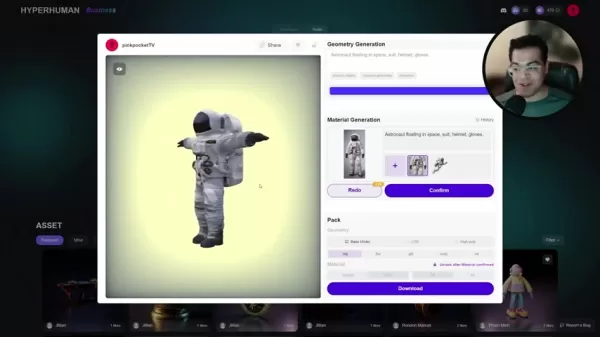
Whether you're a seasoned pro or just starting out, Roden AI gives you the tools to turn your creative ideas into 3D reality. The platform's sophisticated generative model analyzes your input and translates it into detailed 3D representations. With multiple customization options, you can adjust the geometry, materials, and textures to meet your project's specific needs and artistic style. Plus, Roden AI supports various standard 3D file formats, making it easy to integrate your models with other software tools.
Exploring Examples of 3D Models on Roden AI
Before you start creating your own 3D models, it's a good idea to check out the examples already on Roden AI. These examples not only show off the platform's capabilities but can also spark inspiration for your own projects.
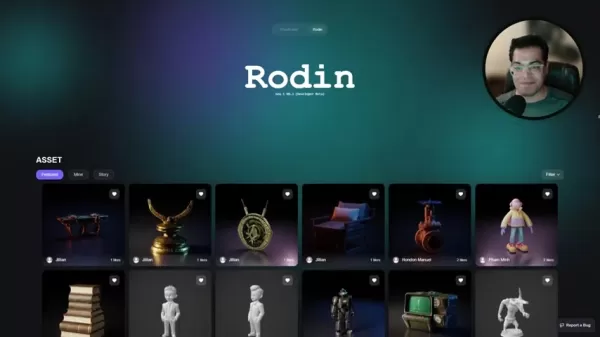
The library on Roden AI is packed with a diverse range of 3D models, from simple objects like books to more intricate characters and architectural elements. You'll find models like Pokémon-inspired characters, detailed Spider-Man busts, and realistic stacks of books. These models are not only visually striking but also showcase the platform's ability to handle fine details and textures. By examining these examples, you can learn how to craft effective prompts and achieve the results you're looking for. Just click on any model to delve deeper into its geometry and material properties. This exploration is key to understanding what Roden AI can do for you.
Creating Your Own 3D Models with Roden AI
Step 1: Navigating to the Roden AI Homepage
First things first, head over to the Roden AI website. You'll be greeted by a user-friendly interface that makes it easy to start creating your 3D models. The 'Text Input' button is right there in the center, ready for you to begin generating models from your text prompts.

Step 2: Inputting Text Prompts
Click on the 'Text Input' button to open the prompt interface. Here, you can describe the 3D model you want to create in detail. The more specific you are, the better the AI can interpret your vision. For example, you might type in 'a knight, cute, mascot, character'.

Once you've entered your prompt, hit confirm, and the AI will generate an initial image based on your description. This image is a preview of how the AI interprets your prompt and is a crucial step in the 3D model creation process.
Step 3: Utilizing Image Uploads
If you prefer, you can also use images to guide the AI's model generation. This is great if you have a specific visual in mind. Look for the image upload option on the homepage, usually marked with a plus sign icon.

Click it, select an image from your computer, and it will appear on the interface, ready to be used as a base for your 3D model.
Step 4: Enabling Transparency
If your uploaded image has an alpha channel, you can enable transparency to keep those transparent areas in your 3D model. This is especially useful for models with intricate details or cut-out sections. Just look for the 'Use Alpha Channel' checkbox and make sure it's selected.
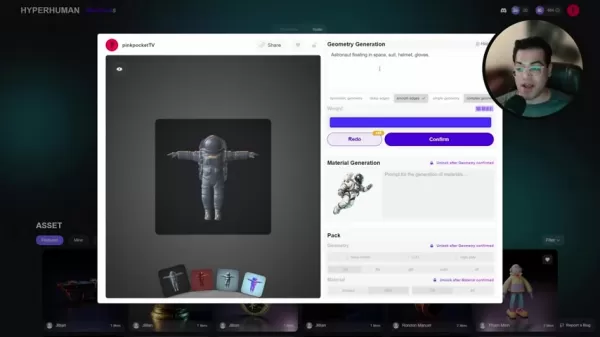
This tells the AI to respect the transparency in your image during model generation.
Step 5: Generating the 3D Model
Now, whether you've used a text prompt or uploaded an image, you're ready to generate your 3D model. Click the 'Generate' button, and Roden AI will analyze your input and create a 3D model based on it. The time it takes can vary depending on the model's complexity and server load.
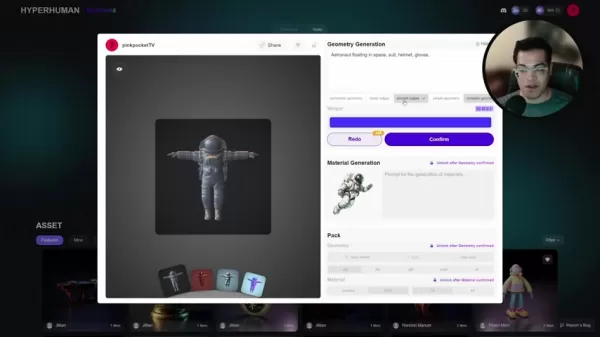
Step 6: Refining the Geometry
Once your initial 3D model is ready, you can refine its geometry to better fit your vision. Roden AI offers various options to tweak the model's characteristics, like edge smoothness and geometric complexity.

Play around with these settings until you're happy with the model's look and feel. You can choose between 'Sharp Edges' or 'Smooth Edges' to control the model's outlines and adjust the weight and symmetry to ensure it reflects your vision accurately.
Step 7: Generating Materials
After you're satisfied with the geometry, it's time to add materials to your 3D model. Materials affect how the model interacts with light, influencing its color, texture, and appearance. Roden AI offers options like shaded and PBR (Physically Based Rendering) materials.
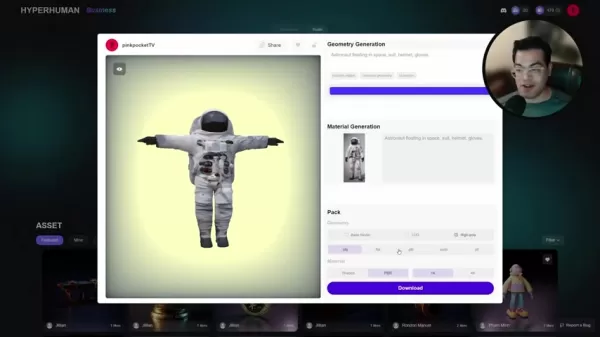
To generate materials, you'll typically need a reference image. By default, Roden AI uses your initial image, but you can also upload a different one specifically for material generation. This allows you to map textures and details from the new image onto your 3D model, creating a unique and visually appealing asset. Click 'Generate' in the material section, and let Roden AI work its magic.
Step 8: Downloading the 3D Model
Once you've refined the geometry and materials to your liking, you can download your final 3D model. Roden AI supports multiple file formats like OBJ, FBX, GLB, USDZ, and STL, ensuring compatibility with various 3D software tools. You can choose between a base model, LOD (Level of Detail) models, or a high-poly source, depending on your needs. Once you've made your selections, click 'Download' and save your 3D model to your computer.
Understanding Roden AI Pricing
Credit-Based System
Roden AI uses a credit-based system, where each action, like generating a 3D model or applying materials, uses up a certain number of credits. You can buy credits in bundles to fuel your creative projects. This system offers flexibility, allowing you to pay only for what you use.
Subscription Plans
For those who use the platform more frequently, Roden AI offers subscription plans that provide a set number of credits each month. These plans often come with discounts compared to buying credits individually. They're ideal for professionals and teams who need a steady supply of credits for ongoing projects. Roden offers different subscription packages to cater to the needs of creators and businesses. Check their pricing page for more details.
Benefits of Using Roden AI for 3D Modeling
Pros
- AI-powered generation speeds up 3D model creation significantly.
- The intuitive interface makes it accessible to users with minimal technical skills.
- Customization options allow for fine-tuning of geometry, materials, and textures.
- Supports multiple download formats for compatibility with various 3D software.
- The credit-based system offers flexible pricing options.
Cons
- May not offer the same level of granular control as traditional 3D modeling software.
- The quality of generated models can vary depending on the prompt or image input.
- Requires an internet connection to use.
- Cost can add up quickly with frequent use, especially without a subscription.
Key Features of Roden AI
AI-Powered 3D Model Generation
The heart of Roden AI's functionality is its ability to generate 3D models from text prompts and image uploads. This is powered by sophisticated AI algorithms that interpret your inputs and translate them into detailed 3D assets. The AI can create a wide variety of models, from characters to objects and environments, making 3D modeling more user-friendly.
Customization Options
Roden AI offers a wide range of customization options, allowing you to fine-tune the geometry, materials, and textures of your 3D models. These options include adjusting edge smoothness, geometric complexity, and material properties. Customization is a key part of Roden's toolkit.
Multiple Download Formats
Roden AI supports multiple file formats for easy integration with other 3D software tools. The available formats include OBJ, FBX, GLB, USDZ, and STL, ensuring compatibility with a wide range of applications. This support is especially helpful for professionals working in teams.
PBR Material Generation
The platform can generate Physically Based Rendering (PBR) materials, which simulate how real-world materials interact with light. PBR materials enhance the realism and visual quality of 3D models. The materials generated ensure a professional look.
Practical Applications of Roden AI
Game Development
Roden AI is a game-changer for game development, allowing for rapid prototyping and creation of 3D assets. Game developers can use the platform to generate characters, objects, and environments, saving time and resources. It's a huge asset for indie game devs on a budget.
Architectural Visualization
Architects and designers can use Roden AI to create 3D visualizations of buildings and interiors. The platform can generate detailed models from architectural plans or sketches, providing a realistic preview of the final design. It's a time-saver in the architectural field.
Product Design
Manufacturers and product designers can use Roden AI to create 3D models of their products for marketing and presentation purposes. The platform can generate high-quality renders and visualizations, showcasing the product's features and design elements. It's an easy way to market your product thanks to AI.
Education
Educators can use Roden AI to teach 3D modeling and design principles. The platform's intuitive interface and AI-powered generation capabilities make it easy for students to learn and experiment with 3D concepts. It's a great way to introduce children to the world of 3D modeling.
Frequently Asked Questions
What file formats does Roden AI support for downloading 3D models?
Roden AI supports several popular 3D file formats, including OBJ, FBX, GLB, USDZ, and STL. These formats are widely compatible with various 3D software applications, ensuring ease of integration into different workflows.
Can I use my own images for material generation?
Yes, Roden AI allows you to upload your own images to guide the material generation process. You can use images of textures, surfaces, or real-world objects to create custom materials that enhance the visual quality of your 3D models.
Is it possible to create 3D models with transparent elements using Roden AI?
Yes, if your uploaded image has an alpha channel, you can enable transparency in Roden AI to preserve the transparent areas in the generated 3D model. This feature is useful for models with intricate details or cut-out sections.
How does Roden AI's credit-based system work?
Roden AI operates on a credit-based system, where each action, such as generating a 3D model or applying materials, consumes a certain number of credits. Users can purchase credits in bundles or subscribe to a monthly plan that provides a fixed number of credits.
Can I refine the geometry of the 3D models generated by Roden AI?
Yes, Roden AI provides several options to refine the geometry of your 3D models. These options include adjusting edge smoothness, geometric complexity, weight, and symmetry to achieve the desired look and feel.
Related Questions
How does Roden AI compare to traditional 3D modeling software?
Roden AI offers a more streamlined and accessible approach to 3D modeling compared to traditional software. Traditional software often requires extensive training and technical expertise, whereas Roden AI simplifies the process with AI-powered generation and intuitive customization options. However, traditional software provides more granular control over every aspect of the modeling process, making it suitable for highly specialized and detailed work. Roden AI is best suited for rapid prototyping, asset creation, and projects where ease of use and speed are paramount. The following table summarizes the key differences:
Feature Roden AI Traditional 3D Software Ease of Use Highly intuitive, AI-powered Requires extensive training Speed Rapid prototyping and asset creation Time-consuming and complex Control Limited customization options Granular control over every detail Cost Credit-based or subscription High upfront cost Expertise Minimal technical expertise required Significant technical expertise required Best Use Rapid prototyping, asset creation Highly specialized and detailed work
While Roden AI makes 3D creation accessible, programs like Blender offer far more control to an artist.
Related article
 AI-Powered Cover Letters: Expert Guide for Journal Submissions
In today's competitive academic publishing environment, crafting an effective cover letter can make the crucial difference in your manuscript's acceptance. Discover how AI-powered tools like ChatGPT can streamline this essential task, helping you cre
AI-Powered Cover Letters: Expert Guide for Journal Submissions
In today's competitive academic publishing environment, crafting an effective cover letter can make the crucial difference in your manuscript's acceptance. Discover how AI-powered tools like ChatGPT can streamline this essential task, helping you cre
 US to Sanction Foreign Officials Over Social Media Regulations
US Takes Stand Against Global Digital Content Regulations
The State Department issued a sharp diplomatic rebuke this week targeting European digital governance policies, signaling escalating tensions over control of online platforms. Secretary Marco
US to Sanction Foreign Officials Over Social Media Regulations
US Takes Stand Against Global Digital Content Regulations
The State Department issued a sharp diplomatic rebuke this week targeting European digital governance policies, signaling escalating tensions over control of online platforms. Secretary Marco
 Ultimate Guide to AI-Powered YouTube Video Summarizers
In our information-rich digital landscape, AI-powered YouTube video summarizers have become indispensable for efficient content consumption. This in-depth guide explores how to build a sophisticated summarization tool using cutting-edge NLP technolog
Comments (1)
0/200
Ultimate Guide to AI-Powered YouTube Video Summarizers
In our information-rich digital landscape, AI-powered YouTube video summarizers have become indispensable for efficient content consumption. This in-depth guide explores how to build a sophisticated summarization tool using cutting-edge NLP technolog
Comments (1)
0/200
![DonaldRoberts]() DonaldRoberts
DonaldRoberts
 August 16, 2025 at 3:01:01 PM EDT
August 16, 2025 at 3:01:01 PM EDT
Whoa, Roden AI sounds like a game-changer! Turning text into 3D models is wild—imagine designing a whole game world just by typing ideas. Gotta try this out soon! 😎


 0
0
3D modeling used to be a daunting task, often requiring specialized skills and pricey software. But thanks to the rise of artificial intelligence, the landscape of 3D modeling is undergoing a dramatic shift, becoming more accessible than ever. Enter Roden AI, a platform that's at the cutting edge of this transformation, simplifying the creation of 3D assets through the power of AI. This article will take you on a journey through Roden AI, exploring its features, capabilities, and how you can harness it to bring your own 3D visions to life.
Key Points
- Roden AI enables the creation of 3D models from text prompts or image uploads.
- Users can customize the geometry, materials, and choose from various download formats.
- Models generated can be further refined in Blender and other 3D software.
- The platform uses a credit-based system with flexible subscription options.
- The technology is evolving quickly, making professional-quality 3D modeling more accessible to everyone.
Introduction to Roden AI
What is Roden AI?
Roden AI is a revolutionary platform that uses AI to generate 3D models, making the traditionally complex process of 3D modeling accessible to a broader audience, including designers, game developers, and hobbyists. By using AI algorithms, Roden AI transforms simple text prompts or uploaded images into a variety of 3D assets. This tool bypasses the need for deep technical knowledge, allowing users to create high-quality 3D models quickly and efficiently. It's perfect for rapid prototyping, asset creation, and visualization projects.

Whether you're a seasoned pro or just starting out, Roden AI gives you the tools to turn your creative ideas into 3D reality. The platform's sophisticated generative model analyzes your input and translates it into detailed 3D representations. With multiple customization options, you can adjust the geometry, materials, and textures to meet your project's specific needs and artistic style. Plus, Roden AI supports various standard 3D file formats, making it easy to integrate your models with other software tools.
Exploring Examples of 3D Models on Roden AI
Before you start creating your own 3D models, it's a good idea to check out the examples already on Roden AI. These examples not only show off the platform's capabilities but can also spark inspiration for your own projects.

The library on Roden AI is packed with a diverse range of 3D models, from simple objects like books to more intricate characters and architectural elements. You'll find models like Pokémon-inspired characters, detailed Spider-Man busts, and realistic stacks of books. These models are not only visually striking but also showcase the platform's ability to handle fine details and textures. By examining these examples, you can learn how to craft effective prompts and achieve the results you're looking for. Just click on any model to delve deeper into its geometry and material properties. This exploration is key to understanding what Roden AI can do for you.
Creating Your Own 3D Models with Roden AI
Step 1: Navigating to the Roden AI Homepage
First things first, head over to the Roden AI website. You'll be greeted by a user-friendly interface that makes it easy to start creating your 3D models. The 'Text Input' button is right there in the center, ready for you to begin generating models from your text prompts.

Step 2: Inputting Text Prompts
Click on the 'Text Input' button to open the prompt interface. Here, you can describe the 3D model you want to create in detail. The more specific you are, the better the AI can interpret your vision. For example, you might type in 'a knight, cute, mascot, character'.

Once you've entered your prompt, hit confirm, and the AI will generate an initial image based on your description. This image is a preview of how the AI interprets your prompt and is a crucial step in the 3D model creation process.
Step 3: Utilizing Image Uploads
If you prefer, you can also use images to guide the AI's model generation. This is great if you have a specific visual in mind. Look for the image upload option on the homepage, usually marked with a plus sign icon.

Click it, select an image from your computer, and it will appear on the interface, ready to be used as a base for your 3D model.
Step 4: Enabling Transparency
If your uploaded image has an alpha channel, you can enable transparency to keep those transparent areas in your 3D model. This is especially useful for models with intricate details or cut-out sections. Just look for the 'Use Alpha Channel' checkbox and make sure it's selected.

This tells the AI to respect the transparency in your image during model generation.
Step 5: Generating the 3D Model
Now, whether you've used a text prompt or uploaded an image, you're ready to generate your 3D model. Click the 'Generate' button, and Roden AI will analyze your input and create a 3D model based on it. The time it takes can vary depending on the model's complexity and server load.

Step 6: Refining the Geometry
Once your initial 3D model is ready, you can refine its geometry to better fit your vision. Roden AI offers various options to tweak the model's characteristics, like edge smoothness and geometric complexity.

Play around with these settings until you're happy with the model's look and feel. You can choose between 'Sharp Edges' or 'Smooth Edges' to control the model's outlines and adjust the weight and symmetry to ensure it reflects your vision accurately.
Step 7: Generating Materials
After you're satisfied with the geometry, it's time to add materials to your 3D model. Materials affect how the model interacts with light, influencing its color, texture, and appearance. Roden AI offers options like shaded and PBR (Physically Based Rendering) materials.

To generate materials, you'll typically need a reference image. By default, Roden AI uses your initial image, but you can also upload a different one specifically for material generation. This allows you to map textures and details from the new image onto your 3D model, creating a unique and visually appealing asset. Click 'Generate' in the material section, and let Roden AI work its magic.
Step 8: Downloading the 3D Model
Once you've refined the geometry and materials to your liking, you can download your final 3D model. Roden AI supports multiple file formats like OBJ, FBX, GLB, USDZ, and STL, ensuring compatibility with various 3D software tools. You can choose between a base model, LOD (Level of Detail) models, or a high-poly source, depending on your needs. Once you've made your selections, click 'Download' and save your 3D model to your computer.
Understanding Roden AI Pricing
Credit-Based System
Roden AI uses a credit-based system, where each action, like generating a 3D model or applying materials, uses up a certain number of credits. You can buy credits in bundles to fuel your creative projects. This system offers flexibility, allowing you to pay only for what you use.
Subscription Plans
For those who use the platform more frequently, Roden AI offers subscription plans that provide a set number of credits each month. These plans often come with discounts compared to buying credits individually. They're ideal for professionals and teams who need a steady supply of credits for ongoing projects. Roden offers different subscription packages to cater to the needs of creators and businesses. Check their pricing page for more details.
Benefits of Using Roden AI for 3D Modeling
Pros
- AI-powered generation speeds up 3D model creation significantly.
- The intuitive interface makes it accessible to users with minimal technical skills.
- Customization options allow for fine-tuning of geometry, materials, and textures.
- Supports multiple download formats for compatibility with various 3D software.
- The credit-based system offers flexible pricing options.
Cons
- May not offer the same level of granular control as traditional 3D modeling software.
- The quality of generated models can vary depending on the prompt or image input.
- Requires an internet connection to use.
- Cost can add up quickly with frequent use, especially without a subscription.
Key Features of Roden AI
AI-Powered 3D Model Generation
The heart of Roden AI's functionality is its ability to generate 3D models from text prompts and image uploads. This is powered by sophisticated AI algorithms that interpret your inputs and translate them into detailed 3D assets. The AI can create a wide variety of models, from characters to objects and environments, making 3D modeling more user-friendly.
Customization Options
Roden AI offers a wide range of customization options, allowing you to fine-tune the geometry, materials, and textures of your 3D models. These options include adjusting edge smoothness, geometric complexity, and material properties. Customization is a key part of Roden's toolkit.
Multiple Download Formats
Roden AI supports multiple file formats for easy integration with other 3D software tools. The available formats include OBJ, FBX, GLB, USDZ, and STL, ensuring compatibility with a wide range of applications. This support is especially helpful for professionals working in teams.
PBR Material Generation
The platform can generate Physically Based Rendering (PBR) materials, which simulate how real-world materials interact with light. PBR materials enhance the realism and visual quality of 3D models. The materials generated ensure a professional look.
Practical Applications of Roden AI
Game Development
Roden AI is a game-changer for game development, allowing for rapid prototyping and creation of 3D assets. Game developers can use the platform to generate characters, objects, and environments, saving time and resources. It's a huge asset for indie game devs on a budget.
Architectural Visualization
Architects and designers can use Roden AI to create 3D visualizations of buildings and interiors. The platform can generate detailed models from architectural plans or sketches, providing a realistic preview of the final design. It's a time-saver in the architectural field.
Product Design
Manufacturers and product designers can use Roden AI to create 3D models of their products for marketing and presentation purposes. The platform can generate high-quality renders and visualizations, showcasing the product's features and design elements. It's an easy way to market your product thanks to AI.
Education
Educators can use Roden AI to teach 3D modeling and design principles. The platform's intuitive interface and AI-powered generation capabilities make it easy for students to learn and experiment with 3D concepts. It's a great way to introduce children to the world of 3D modeling.
Frequently Asked Questions
What file formats does Roden AI support for downloading 3D models?
Roden AI supports several popular 3D file formats, including OBJ, FBX, GLB, USDZ, and STL. These formats are widely compatible with various 3D software applications, ensuring ease of integration into different workflows.
Can I use my own images for material generation?
Yes, Roden AI allows you to upload your own images to guide the material generation process. You can use images of textures, surfaces, or real-world objects to create custom materials that enhance the visual quality of your 3D models.
Is it possible to create 3D models with transparent elements using Roden AI?
Yes, if your uploaded image has an alpha channel, you can enable transparency in Roden AI to preserve the transparent areas in the generated 3D model. This feature is useful for models with intricate details or cut-out sections.
How does Roden AI's credit-based system work?
Roden AI operates on a credit-based system, where each action, such as generating a 3D model or applying materials, consumes a certain number of credits. Users can purchase credits in bundles or subscribe to a monthly plan that provides a fixed number of credits.
Can I refine the geometry of the 3D models generated by Roden AI?
Yes, Roden AI provides several options to refine the geometry of your 3D models. These options include adjusting edge smoothness, geometric complexity, weight, and symmetry to achieve the desired look and feel.
Related Questions
How does Roden AI compare to traditional 3D modeling software?
Roden AI offers a more streamlined and accessible approach to 3D modeling compared to traditional software. Traditional software often requires extensive training and technical expertise, whereas Roden AI simplifies the process with AI-powered generation and intuitive customization options. However, traditional software provides more granular control over every aspect of the modeling process, making it suitable for highly specialized and detailed work. Roden AI is best suited for rapid prototyping, asset creation, and projects where ease of use and speed are paramount. The following table summarizes the key differences:
| Feature | Roden AI | Traditional 3D Software |
|---|---|---|
| Ease of Use | Highly intuitive, AI-powered | Requires extensive training |
| Speed | Rapid prototyping and asset creation | Time-consuming and complex |
| Control | Limited customization options | Granular control over every detail |
| Cost | Credit-based or subscription | High upfront cost |
| Expertise | Minimal technical expertise required | Significant technical expertise required |
| Best Use | Rapid prototyping, asset creation | Highly specialized and detailed work |
While Roden AI makes 3D creation accessible, programs like Blender offer far more control to an artist.
 AI-Powered Cover Letters: Expert Guide for Journal Submissions
In today's competitive academic publishing environment, crafting an effective cover letter can make the crucial difference in your manuscript's acceptance. Discover how AI-powered tools like ChatGPT can streamline this essential task, helping you cre
AI-Powered Cover Letters: Expert Guide for Journal Submissions
In today's competitive academic publishing environment, crafting an effective cover letter can make the crucial difference in your manuscript's acceptance. Discover how AI-powered tools like ChatGPT can streamline this essential task, helping you cre
 US to Sanction Foreign Officials Over Social Media Regulations
US Takes Stand Against Global Digital Content Regulations
The State Department issued a sharp diplomatic rebuke this week targeting European digital governance policies, signaling escalating tensions over control of online platforms. Secretary Marco
US to Sanction Foreign Officials Over Social Media Regulations
US Takes Stand Against Global Digital Content Regulations
The State Department issued a sharp diplomatic rebuke this week targeting European digital governance policies, signaling escalating tensions over control of online platforms. Secretary Marco
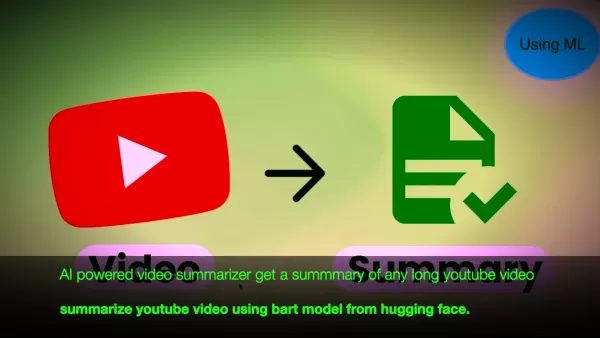 Ultimate Guide to AI-Powered YouTube Video Summarizers
In our information-rich digital landscape, AI-powered YouTube video summarizers have become indispensable for efficient content consumption. This in-depth guide explores how to build a sophisticated summarization tool using cutting-edge NLP technolog
Ultimate Guide to AI-Powered YouTube Video Summarizers
In our information-rich digital landscape, AI-powered YouTube video summarizers have become indispensable for efficient content consumption. This in-depth guide explores how to build a sophisticated summarization tool using cutting-edge NLP technolog
 August 16, 2025 at 3:01:01 PM EDT
August 16, 2025 at 3:01:01 PM EDT
Whoa, Roden AI sounds like a game-changer! Turning text into 3D models is wild—imagine designing a whole game world just by typing ideas. Gotta try this out soon! 😎


 0
0





























